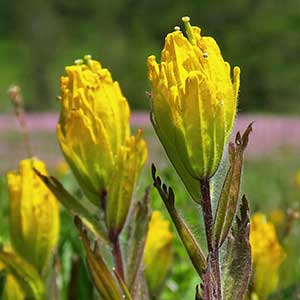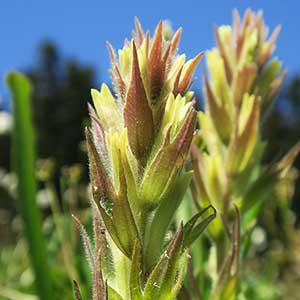Castilleja levisecta
Castilleja cryptantha
golden Indian paintbrush, golden paintbrush
Mt. Rainier or obscure paintbrush, obscure Indian paintbrush, obscure paintbrush
few to many, erect, ± decumbent or creeping at base, unbranched, sometimes branched, hairs spreading, medium length and long, soft, mixed with short stipitate-glandular ones.
few to several, erect or ascending, unbranched, hairs spreading, long, soft, eglandular, mixed with short stipitate-glandular ones.
green to purple or brown-tinged, linear-lanceolate proximally, oblong-ovate or -obovate distally, 0.8–5.2 cm, not fleshy, margins plane, distalmost sometimes ± wavy, involute, 3–7(–11)-lobed, apex obtuse;
lobes erect to ascending, linear to linear-spatulate, very short, toothlike, usually arising from distal 1/3 of blade, apex rounded.
green, often with brown or purple veins, narrowly to broadly lanceolate, 1.5–4 cm, not fleshy, margins plane, ± involute, 0–3-lobed, apex acute to acuminate;
lobes spreading-ascending, narrowly lanceolate, apex acute to ± obtuse.
2.5–25 × 1–4 cm;
bracts bright yellow throughout, or proximally greenish, distally bright yellow, sometimes deep yellow-orange, especially with age, oblong, elliptic, or obtuse to ovate, (0–)5–9(–13)-lobed, sometimes wavy-margined;
lobes erect to ascending, oblong, short to medium length, arising above mid length, central lobe apex rounded, lateral ones rounded to acute.
(2.5–)3–6 × 1–2 cm; green to dull brown or dull reddish purple throughout, or proximally green to dull brown or dull reddish purple, distally yellow on apices, broadly lanceolate to ovate, (0–)3-lobed;
lobes ascending, narrowly lanceolate, long or short, arising near mid length, apex acute or acuminate.
straight or slightly curved, 17–28 mm;
tube 12–15 mm;
beak exserted, adaxially green or greenish yellow, 6–8 mm;
abaxial lip yellow or greenish, reduced, not inflated, 2–3 mm, 25–33(–50)% as long as beak;
teeth ascending to erect, yellow, 0.5–1.5 mm.
straight, 14–16 mm;
tube 11–14 mm;
whole corolla included within calyx;
beak adaxially pale yellow, 1–2 mm;
abaxial lip deep green, slightly inflated, 4–5 mm, 67% as long as beak;
teeth ascending, pale, 1.5–2 mm.
distally yellow, 13–22 mm;
abaxial and adaxial clefts 4–9.5 mm, 30–40% of calyx length, deeper than laterals, lateral 2.5–4.5 mm, ca. 25% of calyx length;
lobes linear to narrowly oblong or narrowly lanceolate, apex obtuse, sometimes rounded to acute.
proximally green or pale with green veins, lobes yellow, sometimes becoming deep red with age, 12–15 mm;
abaxial and adaxial clefts 3–7 mm, 25–50% of calyx length, deeper than laterals, lateral 1–3(–4) mm, 8–20% of calyx length;
lobes triangular, adaxial segments longer than abaxials, apex acute or obtuse.
= 24.
= 24.
Castilleja levisecta
Castilleja cryptantha
Castilleja levisecta is listed as threatened in the United States and endangered in Canada, where it is extremely rare. Most of its grassland habitat has been altered by development in the Puget Trough, and there are historical stations in the metro areas of what are now Victoria, Portland, and Seattle. For several decades, C. levisecta was considered extirpated from Oregon. However, recent reintroduction programs in Oregon and Washington have been very successful at reestablishing this species at several sites in the Willamette Valley. The bright yellow inflorescences often gradually age to a golden yellow color, unique in the genus.
Castilleja levisecta is in the Center for Plant Conservation’s National Collection of Endangered Plants.
(Discussion copyrighted by Flora of North America; reprinted with permission.)
Castilleja cryptantha is endemic to the vicinity of Mt. Rainier in the Cascade Range, with most populations found within Mt. Rainier National Park. Unlike most species of Castilleja, it is apparently self-pollinating (W. J. Duffield 1972); the small flowers are entirely enclosed within the yellowish calyces, which tend to grow deep reddish as they age. The purplish brown bracts are also unusual in the genus.
(Discussion copyrighted by Flora of North America; reprinted with permission.)



